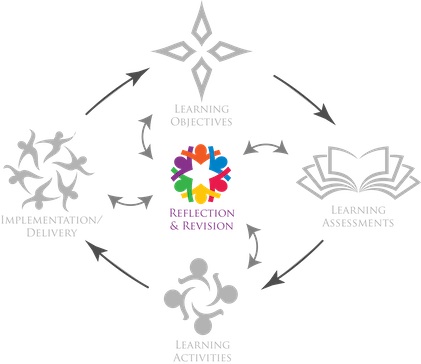Best Practices: Reflection & Revision
UW HomeECTL HomeECTL Knowledge Base HomeBest Practices

Brief Overview
Getting feedback on your active and live course will help you improve and revise the design, content, instructional and assessment measures, and even objectives and outcomes of your course. There are two phases of evaluation, formative and summative. Formative evaluation is iterative and can be done throughout the teaching of the course. Summative evaluation is done at the end of the course.
Instructors should also engage in self-reflection throughout the course (possibly through a teaching journal or brief post-lesson notes) so they are better positioned to make changes.
As you reflect and gather other information on your course, here are some questions to consider:
- Did the student meet the course objectives? How do you know?
- What does formative student feedback tell you?
- What does summative student performance tell you?
- Do you need to change content?
- Do you need to change learning activities?
- Do you need to change instructional strategies?
Formative evaluations can be done in a variety of ways from midterm surveys to open-ended questions on assignments or quizzes. Summative evaluations of the course are different from grades. In this case you are looking at course design and if it was effective. Determining if students met the learning outcomes is one way to examine your course. Student evaluations may also be helpful.
Key Topics and Links
Reflection as a Component of Course Revision
Reflecting on course design and delivery can provide a powerful way to initiate relevant revisions to your courses. Some possible ways to reflect on course design and delivery include
- Gathering student perspectives
- Keeping a teaching journal
- Reviewing your course with a rubric (see below)
Steven McGahan’s article “Reflective Course Review and Revision” provides more information and ideas for integrating into course revision processes.
Evaluating Online Course Design
A number of systems, models, and rubrics can support the design and evaluation of online courses. Not all rubrics include criteria that apply to the course teaching and learning stage, but all include elements related to the design phase (Ko & Rossen, 2017)--and many rubrics can be adapted to guide revision of design of face-to-face course learning as well. Several rubrics are provided below to help you evaluate the quality of online courses.
- Quality Matters Rubric
- The University of Illinois Springfield | Quality Online Course Initiative (QOCI) Rubric
- California State University | Chico Rubric for Online Instruction
- The SUNY Online Course Quality Review Rubric OSCQR
- CSU | QLT Instrument
- Benchmarking Quality in Online Teaching and Learning: A Rubric for Course Construction and Evaluation | The Journal of Effective Teaching
More About Quality Matters
- You can also use the QM Self Review tool to review your course. For more information on QM Self Review tool go to QM website.
- University of Wyoming is a Quality Matters (QM) member with a full (institutional) subscription. Please contact UW QM Coordinators Oksana Wasilik (oksana@uwyo.edu) or Christi Boggs (cboggs@uwyo.edu) if you want to have a QM account affiliated with UW or for information regarding QM training opportunities.
Want more help? Reach out to ECTL staff at wyocourses-inst@uwyo.edu
